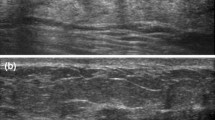Abstract
Objective
To prospectively determine the upgrade rate following surgery in benign papilloma initially diagnosed at ultrasound (US)-guided 14-gauge gun biopsy.
Methods
A total of 128 benign papillomas were diagnosed in 114 patients after a US-guided biopsy. Surgical excision was recommended where the biopsy indicated benign papilloma, regardless of imaging findings. The upgrade rate to ‘atypical’ and ‘malignancy’ was measured on a per-lesion basis. We analysed potential associations between clinical presentation, lesion variables and the results of surgical excision (using logistic regression).
Results
Of the 114 patients, 87 eventually underwent surgery: among the 100 supposed benign papillomas, surgical excision revealed fibrocystic change or no residual lesion in nine cases, intraductal papilloma in 74, atypical papilloma in 13, papillary ductal carcinoma in situ (DCIS) in three and one invasive papillary carcinoma. The upgrade rate for an atypical papilloma or papilloma with adjacent foci of atypical ductal hyperplasia (ADH) and malignancy was 13% (95% CI = 7.1–21.2%) and 4% (95% CI = 1.1–9.9%), respectively. The mean lesion size (P = 0.041) was significantly larger when lesions were upgraded to malignancy. Other features were not significantly associated with pathological underestimation (P > 0.05).
Conclusion
Surgical excision should be considered for benign intraductal papillomas above 1.5 cm in size.



Similar content being viewed by others
References
Liberman L (2000) Clinical management issues in percutaneous core breast biopsy. Radiol Clin North Am 38:791–807
Tavassoli F (2003) Intraductal papillary neoplasms. In: Tavassoli FA, Young RH, Stratton MR (eds) WHO classification of tumours pathology and genetics of tumours of the breast and female genital organs. IARC, Lyon, pp 76–80
Tavassoli FA (1992) Papillary lesions. In: Tavassoli FA (ed) Pathology of the breast. Appleton & Lange, Norwalk, Conn, pp 193–227
Mercado CL, Hamele-Bena D, Singer C, Koenigsberg T, Pile-Spellman E, Higgins H, Smith SJ (2001) Papillary lesions of the breast: evaluation with stereotactic directional vacuum assisted biopsy. Radiology 221:650–655
Reynolds HE (2000) Core needle biopsy of challenging benign breast conditions: a comprehensive literature review. AJR Am J Roentgenol 174:1245–1250
Ivan D, Selinko V, Sahin AA, Sneige N, Middleton LP (2004) Accuracy of core needle biopsy diagnosis in assessing papillary breast lesions: histologic predictors of malignancy. Mod Pathol 17:165–171
Agoff SN, Lawton TJ (2004) Papillary lesions of the breast with and without atypical ductal hyperplasia: can we accurately predict benign behavior from core needle biopsy? Am J Clin Pathol 122:440–443
American College of Radiology (2003) Breast imaging reporting and data system—mammography (BI-RADS™), 4th edn. American College of Radiology, Reston
American College of Radiology (2003) Breast imaging reporting and data system—ultrasound (BI-RADS™), 4th edn. American College of Radiology, Reston
Heinze G, Schemper M (2002) A solution to the problem of separation in logistic regression. Stat Med 21:2409–2419
Heinze G, Ploner M (2003) Fixing the nonconvergence bug in logistic regression with SPLUS and SAS. Comput Methods Programs Biomed 71:181–187
Valdes EK, Feldman SM, Boolbol SK (2007) Papillary lesions: a review of the literature. Ann Surg Oncol 14:1009–1013
Sydnor MK, Wilson JD, Hijaz TA, Massey HD, Shaw de Paredes ES (2007) Underestimation of the presence of breast carcinoma in papillary lesions initially diagnosed at core-needle biopsy. Radiology 242:58–62
Liberman L, Tornos C, Huzjan R, Bartella L, Morris EA, Dershaw DD (2006) Is surgical excision warranted after benign, concordant diagnosis of papilloma at percutaneous breast biopsy? AJR Am J Roentgenol 186:1328–1334
Mercado CL, Hamele-Bena D, Oken SM, Singer CI, Cangiarella J (2006) Papillary lesions of the breast at percutaneous core-needle biopsy. Radiology 238:801–808
Ganesan S, Karthik G, Joshi M, Damodaran V (2006) Ultrasound spectrum in intraductal papillary neoplasms of breast. Br J Radiol 79:843–849
Lam W, Chu W, Tang A, Tse G, Ma T (2006) Role of radiologic features in the management of papillary lesions of the breast. AJR Am J Roentgenol 186:1322–1327
Jacobs TW, Connolly JL, Schnitt SJ (2002) Nonmalignant lesions in breast core needle biopsies: to excise or not to excise? Am J Surg Pathol 26:1095–1110
Page DL, Salhany KE, Jensen RA, Dupont WD (1996) Subsequent breast carcinoma risk after biopsy with atypia in breast papilloma. Cancer 78:258–266
Jackman RJ, Birdwell RL, Ikeda DM (2002) Atypical ductal hyperplasia: can some lesions be defined as probably benign after stereotactic 11-gauge vacuum-assisted biopsy, eliminating the recommendation for surgical excision? Radiology 224:548–554
Acknowledgements
This study was supported by a grant (A070001) from the Korea Healthcare Technology R and D Project, and a grant (A01185) from the National R&D Program for Cancer Control, Ministry for Health, Welfare and Family Affairs, Republic of Korea.
Author information
Authors and Affiliations
Corresponding author
Rights and permissions
About this article
Cite this article
Chang, J.M., Moon, W.K., Cho, N. et al. Risk of carcinoma after subsequent excision of benign papilloma initially diagnosed with an ultrasound (US)-guided 14-gauge core needle biopsy: a prospective observational study. Eur Radiol 20, 1093–1100 (2010). https://doi.org/10.1007/s00330-009-1649-2
Received:
Revised:
Accepted:
Published:
Issue Date:
DOI: https://doi.org/10.1007/s00330-009-1649-2




